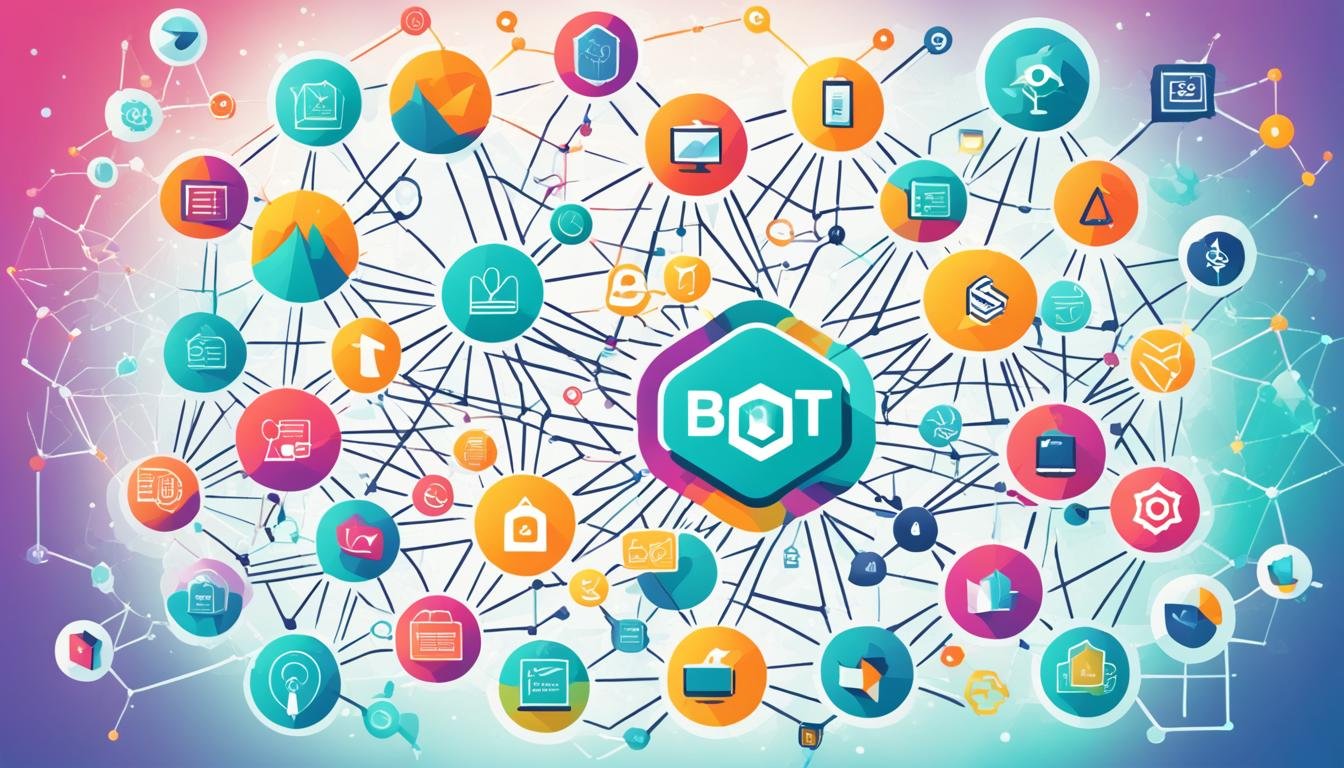Blockchain in Digital Advertising: Ensuring transparency and trust.
Imagine a world where ad fraud drops by $84 billion in 2023. That’s the promise of blockchain technology, a game-changer in digital ads. Charles Lange and others see it as a way to fix the ad industry’s big problems. They aim to make digital ads more secure and transparent.
Blockchain is all about secure, verifiable transactions. It could change how we track ad campaigns. With the market growing from $7.4 billion in 2022 to over $94 billion by 2027, it’s time to explore its role in digital ads. Blockchain can help build trust and make digital ads more transparent.
According to PwC, 71% of consumers don’t trust companies with their data. Blockchain could change that. It offers clear, unchangeable records. This could lead to a more honest digital ad world.
Key Takeaways
- Blockchain technology can significantly reduce issues related to ad fraud, potentially saving billions of dollars.
- Enhancing transparency through blockchain can build trust among consumers and advertisers alike.
- The blockchain market is growing rapidly, highlighting the increasing relevance and potential in digital advertising.
- Adopting blockchain can create verifiable, immutable records that enhance trust in ad campaigns.
- Charles Lange and other industry pioneers are leading the charge in exploring blockchain’s practical applications.
Introduction to Blockchain in Digital Advertising
Blockchain is not just about cryptocurrencies anymore. It’s now set to change the digital advertising world. This tech has the power to fix many problems in the industry.
Blockchain’s core features, like being decentralized and transparent, offer a new way to fight ad fraud and clear up financial transactions. With spending on digital ads expected to hit US$1 trillion by 2027, the industry needs a strong solution to stop waste and fraud. Blockchain lets us track transactions in real-time, making sure every ad is counted right. This is key for Programmatic Advertising and keeping trust.
Decentralized Ad Networks do more than just check transactions. They cut down on middleman fees, making ad exchanges cheaper. For example, New York Interactive Advertising Exchange (NYIAX) uses smart contracts to make things run smoother. Plus, platforms like Brave pay users for watching ads, fighting ad overload and boosting engagement.
With ad fraud expected to hit $100 billion this year, blockchain’s secure ledger could change the game. It offers clear and safe records, fighting fraud and protecting data. This creates a safe space for brands and consumers to meet without fraud worries.
Adopting blockchain in digital advertising faces hurdles, like the current display ad mess. But, its long-term perks, like being clear, cutting costs, and keeping data safe, make it a strong choice for the industry’s needs.
“Blockchain ensures data security, provides transparent and reliable marketing campaigns, and facilitates accurate lead generation through incentivized data sharing, leading to more effective marketing strategies.”
- Ad fraud cost the digital advertising industry $81 billion in 2022, escalating to $100 billion currently.
- Blockchain can reduce intermediary fees in ad exchanges, making them more efficient and cost-effective.
- Blockchain integration offers real-time transaction tracking, ensuring the accuracy of ad impressions.
- Blockchain initiatives like Brave enhance user engagement and address ad fatigue by rewarding viewers with digital currency.
Looking closer at blockchain in digital advertising shows it’s a game-changer. It promises a future that’s more open, efficient, and secure for marketing.
The Need for Transparency in Digital Advertising
Digital advertising is growing fast, making it crucial to be open about ad spending. In 2019, UK advertisers spent £15.69 billion on digital ads, a 15.4% increase from the year before. This growth has raised concerns, mainly because of ad fraud.
The Shadow of Ad Fraud
Ad fraud is a big problem, stealing billions from the industry every year. Using Digital Ad Tracking technologies can help fight this fraud. Blockchain technology can verify and record every step in the ad process, making it safer.
Blockchain uses a digital ledger to check transactions in real-time. This helps prove that digital ads are genuine and stops fraud.
Current Transparency Challenges
The digital ad world is complex, making it hard to be transparent. Data can get lost or altered by fraud or mistakes. Without clear ad spending, brands find it hard to manage their budgets well.
Blockchain offers a solution by recording and checking every transaction. This builds trust in ad campaigns.
For trust to grow in the ad industry, everyone needs to work together. As blockchain gets better at handling transactions, we’ll need flexible rules to keep up with new laws. Blockchain’s success in digital ads depends on being open, responsible, and efficient.
How Blockchain Enhances Trust
Blockchain is changing how trust is built in digital advertising. It creates secure, transparent, and honest systems. This helps solve big problems in the industry.
Immutable Records
Blockchain makes records that can’t be changed. In digital ads, every action, like views or clicks, is saved forever. This means data is always reliable and can’t be faked, cutting down on ad fraud.
These secure records build trust and make everyone in the ad world accountable.
Decentralization and Security
Blockchain is also about being spread out and secure. It’s not like a single database that hackers can get into. Instead, it’s on many nodes, making it hard to change data.
This way, it’s super secure and can’t be easily broken. It also stops any single part from failing, making ads safer and more reliable.
Using blockchain in ads is fighting ad fraud, and it’s working. A big media company used blockchain and saw less fake traffic. Amino Payments also shows how blockchain makes ad transactions clear and safe.
As blockchain gets better, it will make digital ads more trustworthy and efficient. With its secure and clear records, it’s changing the game in digital advertising. Blockchain is making ads more reliable and trustworthy for everyone.
Combating Ad Fraud with Blockchain
The digital ad world is growing fast, making it crucial to fight fraud. Billions are lost each year to scams like ad fraud. Blockchain technology brings unmatched transparency and integrity. It ensures secure transactions and keeps a record of every action, making it hard to fake anything.
Verification of Ad Impressions
It’s key to check if ads are really seen to stop fraud. Blockchain makes sure each ad view is real by keeping a secure record. This way, advertisers can trust that their ads are seen by real people, not bots. It also stops fake numbers from being reported, making ads more reliable.
Proof of Completion for Transactions
Blockchain gives clear proof of ad transactions, helping fight fraud. It tracks every step of an ad’s journey, making everything clear and checkable. This means advertisers can be sure their money is well spent and only on real interactions.
Blockchain-Based Ad Auctions also make buying ad space fair and clear. This boosts trust and makes digital ads more effective.
Real-World Applications of Blockchain in Digital Advertising
Blockchain technology is changing the game in digital advertising. With Tokenized Digital Advertising, companies are making ads more transparent and efficient. They’re also building trust. Let’s look at two interesting Case Studies in Blockchain Advertising.
Case Study: A Global Beverage Company
A big name in beverages used blockchain to fight ad fraud. They cut down on fraud by checking every ad impression with smart contracts. This made a clear record of their ad campaigns, making their marketing more credible and effective.
Case Study: A Media Giant
Another big media company used blockchain to make their ad buying better. They saw less fake traffic and better ad value. Blockchain’s secure and open nature helped them build a trustworthy space for advertisers. This meant every ad was real and could be checked.
Smart Contracts in Advertising
Smart contracts in advertising change the game by automating and making transactions clear. They set terms that automatically go into effect when certain conditions are met. For instance, payments can be made when a certain number of ads are shown or when people engage with them, making sure everything is fair and speeding up payments.
Smart contracts help solve big problems like ad fraud, which costs billions each year. Blockchain’s secure ledger makes sure every ad deal and placement is checked, cutting down on mistakes and building trust.
Blockchain-Based Ad Auctions are another cool use of smart contracts. They make auctions clear and safe, offering a smooth way for real-time bidding and ad spots. Smart contracts cut out middlemen, lowering costs in programmatic ads.
Blockchain also keeps consumer data safe and helps target ads better. It makes sure data is safe and only shared as agreed, letting advertisers send more tailored and effective ads to people.
More and more, smart contracts and decentralized ad exchanges are becoming key in digital ads. Experts believe they’ll make the ad world more open, safe, and efficient. Projects like the Basic Attention Token (BAT) on Ethereum show how blockchain is changing ads for the better.
With blockchain on the rise, groups like the IAB Tech Lab’s Blockchain Working Group are vital. They set standards and look into new uses of blockchain. These efforts help make blockchain work well, overcoming issues like speed and working together with different systems. It’s clear smart contracts in ads are here to stay, bringing a big change to digital ads.
Enhancing Transparency in Ad Spend
Blockchain brings a big change to digital ads by making ad spending clear and open. It shows where money goes, making sure there are no hidden fees. This means advertisers can see exactly how their money is used, making them more responsible with their budgets.
Tracking Budget Allocations
Blockchain helps advertisers see every dollar’s journey. Old ways of advertising often had fake clicks and views, wasting money. But blockchain fixes this by tracking every transaction in real-time. This makes sure every ad click is real.
This transparency in ad spend lets marketers use their money better. They can cut costs and put more into successful campaigns.
Ensuring Accountability in Expenditures
Blockchain makes sure ad spending is honest and clear. Every deal is on a public ledger that can’t be changed. This lets advertisers check their spending easily.
This stops fraud and makes everyone trust the system more. It also helps follow the rules of advertising and laws, making ad spending more reliable.
Blockchain-based Ad Networks
Blockchain-based ad networks are changing the way ads work online. They let advertisers and publishers talk directly, cutting out the middlemen. This makes ads cheaper and more efficient. It also adds transparency and trust to the process.
Blockchain in Digital Advertising helps both advertisers and publishers. It makes sure ad deals are clear and safe. For example, IBM uses blockchain to check the ad supply chain. This cuts down on waste and makes data more reliable.
NYIAX and Nasdaq work together to trade advertising contracts on their blockchain marketplace. This shows how blockchain can be used in many ways.
Brands and platforms are getting better at marketing with Programmatic Advertising and blockchain. Verasity’s VeraViews uses blockchain to make sure ads are seen and counted right. This is key in today’s fast-paced online world.
Ambire AdEx is another example. It’s a free platform that gives real-time reports on how well ads are doing. This helps publishers make more money.
Ad fraud is a big problem, causing huge financial losses. Blockchain can fight this by checking ad views and making sure ads get to real people. Brave’s blockchain tech blocks bad ads and rewards users with Basic Attention Tokens for safe, engaging ads. This means ads work better and advertisers get real results.
The digital advertising market is growing fast, expected to hit $946.9 billion by 2027. Decentralized and transparent tech like blockchain will play a big part in this growth. By using blockchain-based ad networks, companies can create a safer, more honest digital ad world.
Role of Cryptocurrency in Ad Payments
Using cryptocurrency for ad payments changes the game in digital ads. It makes transactions quick, secure, and clear. This is thanks to blockchain technology.
With digital ad tracking, advertisers can keep a close eye on their ads. They know exactly how many people saw or clicked on their ads. This helps stop ad fraud and make sure ads work better.
Blockchain-based ad auctions bring more efficiency and fairness to ads. They let advertisers bid in real-time and make sure every deal is clear and secure. This cuts down on fraud and makes things fair for everyone in the ad world.
In 2021, NFTs became very popular, showing how blockchain can help many areas like music, trading cards, and art. This shows blockchain’s big impact on changing how we do digital transactions and connect with each other.
Companies like BlockApps, CoinDCX, and Tata Communications are leading the way with blockchain. They use it to make their work more secure and transparent. This proves blockchain’s value in making transactions safer and more reliable.
In summary, using cryptocurrency for ad payments is a big leap forward. It brings huge benefits in speed, security, and clarity. This confirms blockchain’s key role in changing how digital ads are bought, sold, and tracked.
Blockchain’s Impact on Data Privacy and Security
Blockchain has changed how we think about data privacy and security in digital ads. It uses decentralized storage and gives users control over their data. This makes data safe and builds trust.
Decentralized Data Storage
Storing data in many places reduces the chance of cyber threats. This method protects data and follows strict rules like GDPR. Blockchain’s secure features keep data safe and reliable, making it easier to check and trust.
Empowering Consumers with Data Control
Blockchain lets users control their data, deciding who can see it. It uses special codes to protect information, letting users share or stop sharing it. This matches up with today’s privacy laws, building trust and getting more people involved.
“Blockchain offers a robust solution for businesses to build trust, protect data, and optimize marketing efforts, providing a transparent, fraud-resistant, and consumer-centric approach to digital advertising.”
Challenges and Obstacles in Implementing Blockchain
Blockchain technology is full of promise, but it comes with big challenges for companies.
Regulatory Uncertainty
A big issue is the regulatory uncertainty in blockchain implementation. Laws and standards for blockchain are still unclear in many places. This makes it hard for businesses, especially in strict industries, to follow the rules.
Scalability Issues
Another big problem is scalability in decentralized networks. Blockchain networks can’t handle many transactions at once, leading to delays and high fees. This slows down how fast businesses can use blockchain.
High Initial Investment
The cost of getting into blockchain is also a big hurdle. It’s hard and expensive to blend blockchain with current systems. Companies need to spend a lot on new infrastructure, training, and experts. This makes the switch slow and tough.
Many companies struggle to understand what blockchain can do. The high upfront costs and unclear rules add to the challenge. These hurdles make it hard for businesses to fully use blockchain technology.
Future of Blockchain in Digital Advertising
Blockchain technology is set to change digital advertising a lot. It will bring new innovations like smart contracts and better network connections. These changes will make the industry work better.
Expected Growth and Adoption
Blockchain in digital ads is expected to grow a lot. It will help make ads more trustworthy and transparent. Ad fraud costs a lot of money each year, but blockchain can stop this by keeping records safe and secure.
With blockchain, advertisers can track where their ads are shown and who sees them. This means they can be sure their ads are working well. It also helps content creators get paid fairly for their work, making the industry more ethical.
Collaborations and Innovations
Working together is key for blockchain to succeed in advertising. Partnerships will help make blockchain more standard and widely accepted. They can remove barriers caused by technology and laws.
These partnerships can lead to new ideas in blockchain advertising. For example, users could get rewards in cryptocurrency for engaging with ads. This makes customers happier and helps ads work better through smart contracts.
For blockchain to really take off, it needs to follow the law and solve scalability issues. Laws like GDPR and CCPA show how important protecting data is. Blockchain can keep consumer data safe and build trust.
Even though blockchain needs special skills, it can change digital marketing for the better. The future is about working through challenges to make blockchain a key part of digital advertising.
Conclusion
Blockchain technology is changing digital advertising for the better. It brings new levels of transparency and trust. This means advertisers and publishers can get fair pay without middlemen.
With blockchain, we can trust that ads are seen by the right people and not lost to fraud. This is because blockchain checks ad transactions in real-time.
Blockchain fights against fake traffic and click-fraud. It makes advertising more secure than old methods like Facebook and Google ads. These platforms made over $450 billion in 2023 from ads.
Blockchain helps target ads better by using exact customer data. This makes ads more effective.
Consumers now have more control over their data thanks to blockchain. This is good for privacy and security. Tools like Verasity’s VeraViews and Brave browser show how blockchain can make ads better.
Blockchain makes sure ad spending is clear and trustworthy. It also makes ads cheaper and better for consumers. As blockchain grows, it will likely bring more changes and innovations to digital ads.
Source Links
- Council Post: How Blockchain Is Revolutionizing Trust In Digital Advertising
- Blockchain in advertising – Is it the answer to digital advertising’s trust and transparency gap?
- Blockchain: Transforming Transparency and Accountability | Big Drop
- Blockchain on Marketing and Advertising – Blockchain Council
- Linking blockchain technology and digital advertising: How blockchain technology can enhance digital advertising to be more effective, efficient, and trustworthy
- Can Blockchain Improve Trust in Digital Advertising?
- Revolutionizing Advertising with Blockchain Technology
- The Role of Blockchain in Transforming Digital Advertising
- Blockchain for Transparency in Digital Advertising: The Future of Trust in Marketing
- The Role of Blockchain in Digital Marketing: Transparency and Trust
- Blockchain for Transparency in Digital Advertising: The Future of Trust in Marketing
- Blockchain Technology: Revolutionizing Digital Advertising
- Leveraging Blockchain Technology in Digital Advertising: Enhancing Transparency, Security, and Ad Fraud Prevention | Marin Software Blog
- Blockchain Marketing: The Next Frontier In Digital Advertising – Geek Alabama
- How Can Blockchain Technology Improve Crypto Advertising Services?
- The Rise of Blockchain in Marketing: Benefits & Challenges
- The Impact of Blockchain on Digital Advertising
- Blockchain for Advertising
- Blockchain in Digital Marketing: Security and Transparency – OKMG
- Blockchain for Marketers: Enhancing Transparency and Trust
- 10 Blockchain in Advertising and Marketing Examples | Built In
- Blockchain for Transparency in Digital Advertising: The Future of Trust in Marketing
- Blockchain in Digital Advertising: Transparency And Security
- How blockchain is changing Media Advertising and Entertainment market
- Blockchain Marketing Breakthroughs: Redefining the Industry
- The Role of Blockchain in Digital Marketing and Data Security
- Blockchain’s Impact on Marketing Transparency and Security • Neosmart | Insights
- 7 Common Challenges in Blockchain Implementation
- Council Post: Overcoming The Obstacles To Implementing Blockchain Technology
- The 5 Biggest Problems With Blockchain Technology Everyone Must Know About
- Is Blockchain Technology the Future of Digital Marketing?
- Blockchain and Its Role in Transforming Digital Marketing
- The Role of Blockchain in Digital Advertising | Reintech media
- What The Blockchain Means For Marketing – SK Agency







